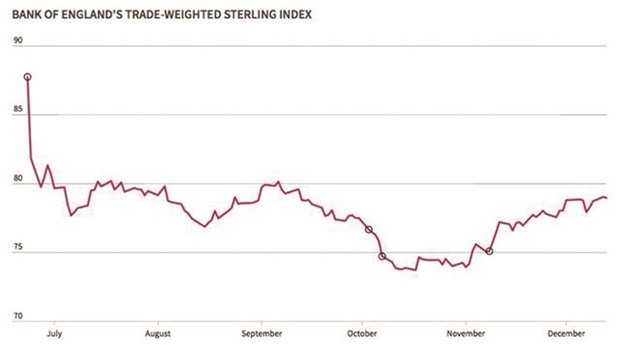Mark Carney says his tolerance for faster inflation is limited, and the signs are that those limits will be tested.
As the Bank of England governor prepares to deliver his first speech of 2017 later yesterday, a report that Prime Minister Theresa May is pushing towards a so-called hard Brexit is weakening the pound. Should that persist, it has implications for consumer prices, already rising at the quickest pace since 2014, and exacerbates the tensions facing policy makers who are trying to support economic growth without letting inflation get out of hand.
Sterling slid below $1.20 for the first time in more than three months after newspapers reported that May will signal in a speech today her willingness to quit the European Union’s single market for goods and services to regain control of Britain’s borders and laws. It’s the outcome seen by many economists as the least desirable, and the one currency traders have fretted about since the UK’s June vote to leave the bloc.
“The main source of inflation does seem to be sterling and the pass-through is very clear and we’ve broken some key levels,” Steven Major, global head of fixed income research at HSBC, said on Bloomberg Television. “The question is whether it affects what the Bank of England is thinking or whether they view it as transitory.”
The pound slid as much as 1.6% to $1.1986, dropping to the weakest since the “flash crash” of October 7. It was at $1.2056 at 12:37 pm London time. Inflation expectations climbed, with the 10-year break-even rate, a gauge of the bond market’s outlook for UK price growth over the next decade, touching the highest since July 2013.
Government officials told the Sunday Times that they expect May’s comments to cause a “market correction.” The BoE declined to comment on the contents of Carney’s address.
On the day May speaks, data will probably show inflation accelerated to 1.4% in December from 1.2%. While that’s below the BOE’s 2% target, it’s forecast to breach that level within months as the pound’s 19% slide since the referendum feeds through to import prices.
The latest decline in sterling means BoE officials may have to make the uncomfortable decision between tolerating an even bigger inflation overshoot or tightening policy – even if that causes more short-term pain – to keep price-growth in check. The central bank will publish new forecasts for growth and inflation on February 2, when it is also scheduled to announce its next policy decision.
The Monetary Policy Committee members have a neutral bias on where rates will go next as they monitor the economic fallout from the decision to quit the EU. While the referendum initially spurred them to cut interest rates and resume asset purchases, and to signal that another rate cut was likely, their stance changed after the economy proved more robust than expected.
The BoE is probably still some way from a rate change. The median forecast of economists is for no change from the current record-low 0.25% until at least the second quarter of 2019. When that move comes, there’s a higher chance of a hike, according to a survey conducted last week.

.
